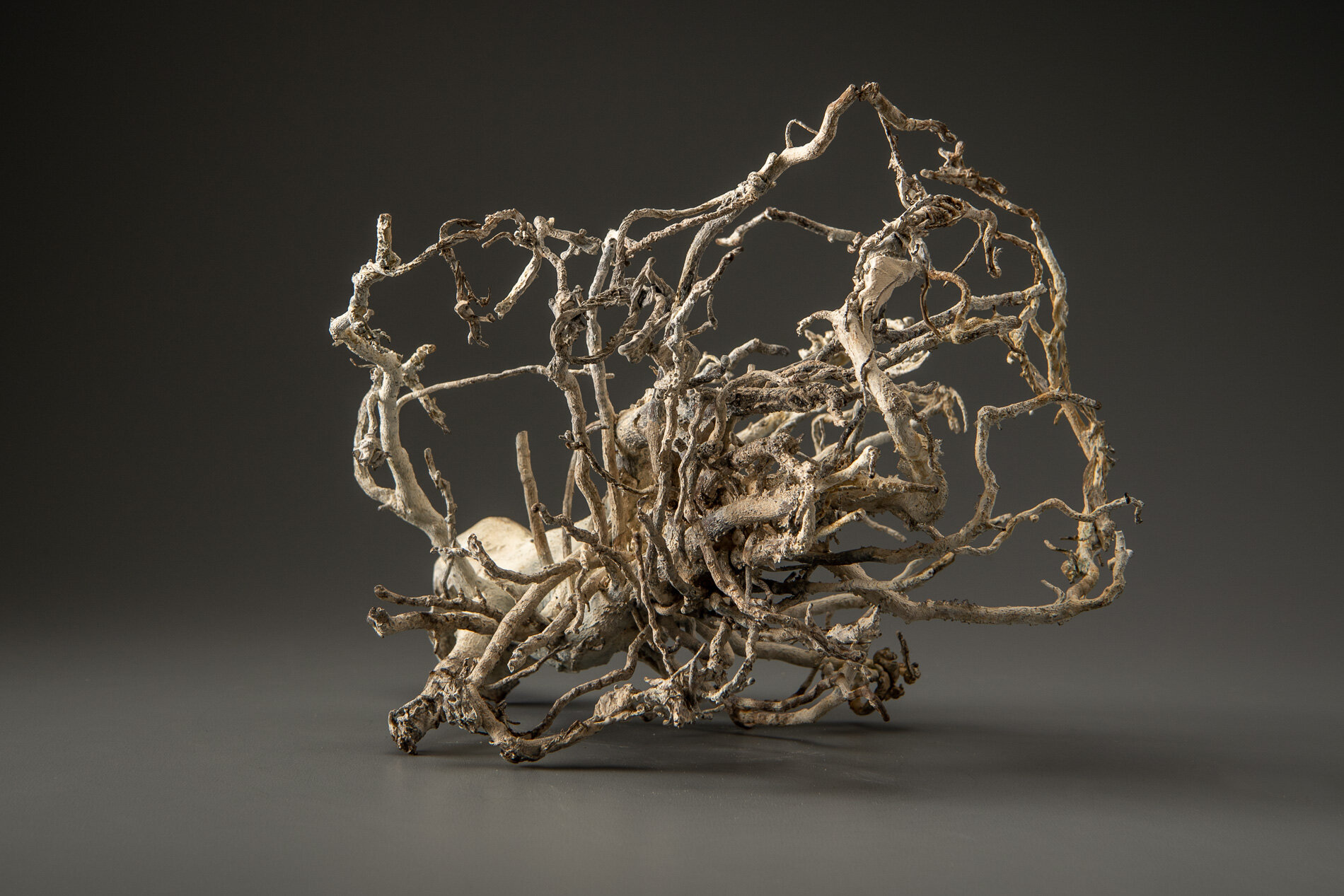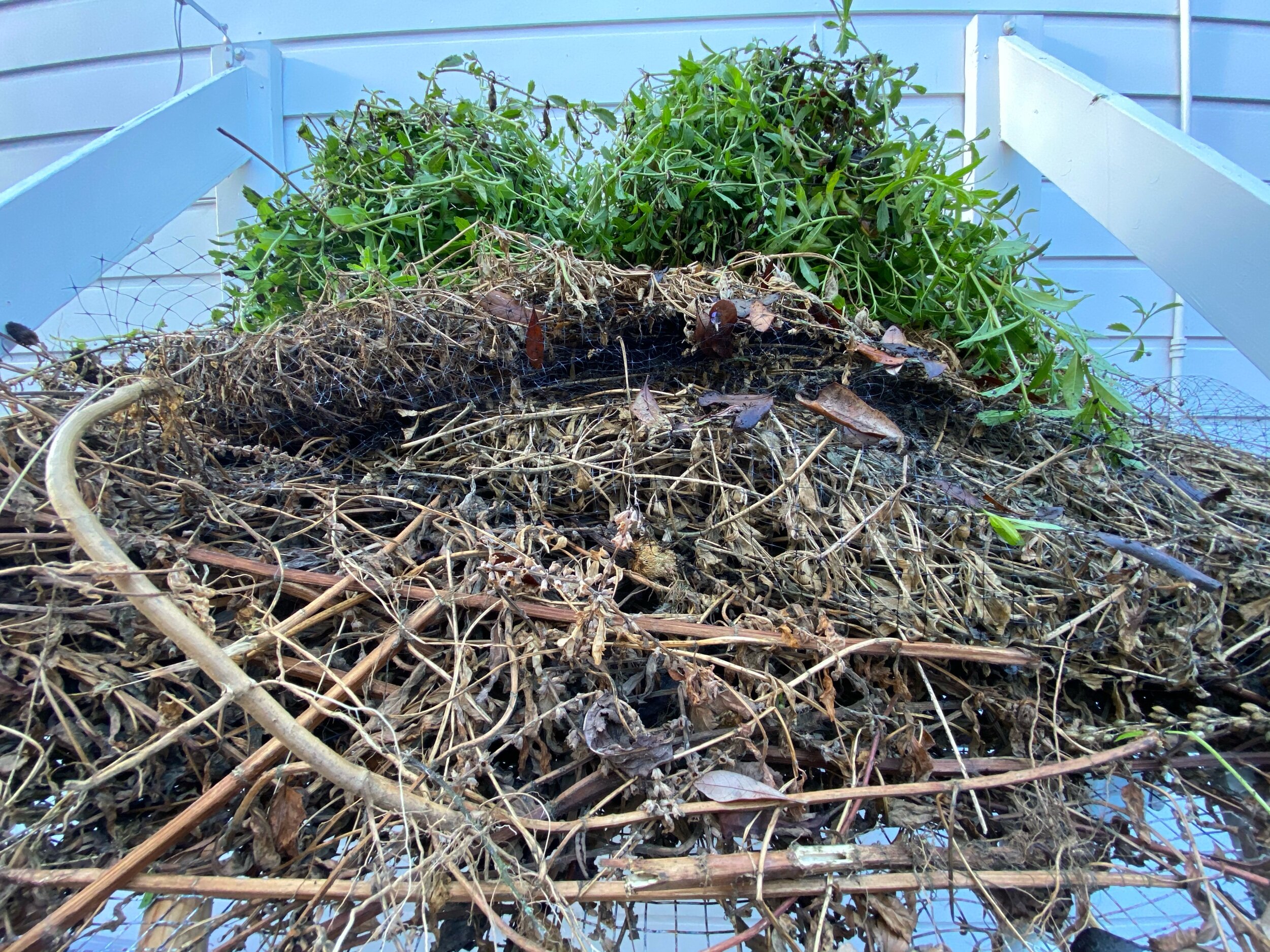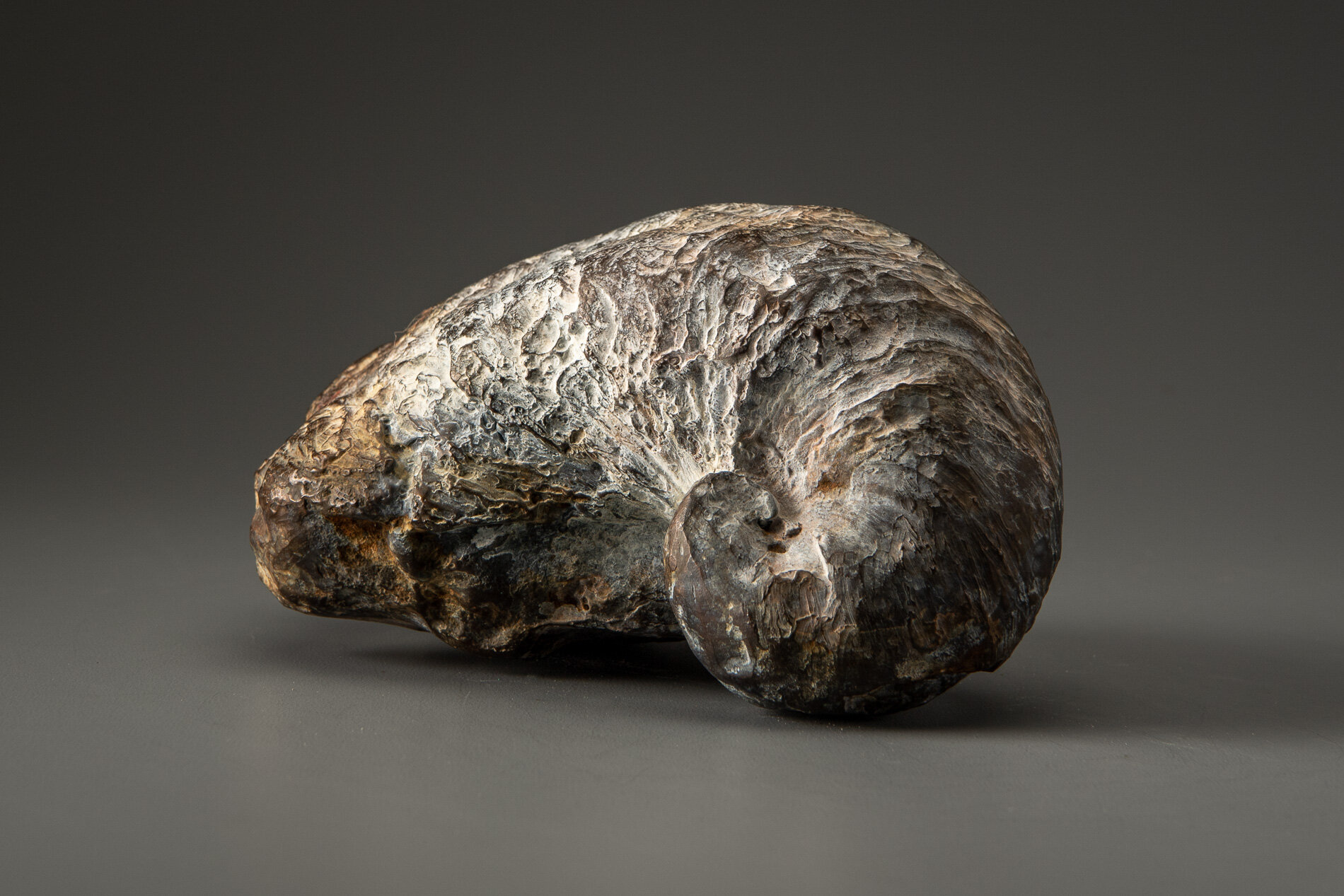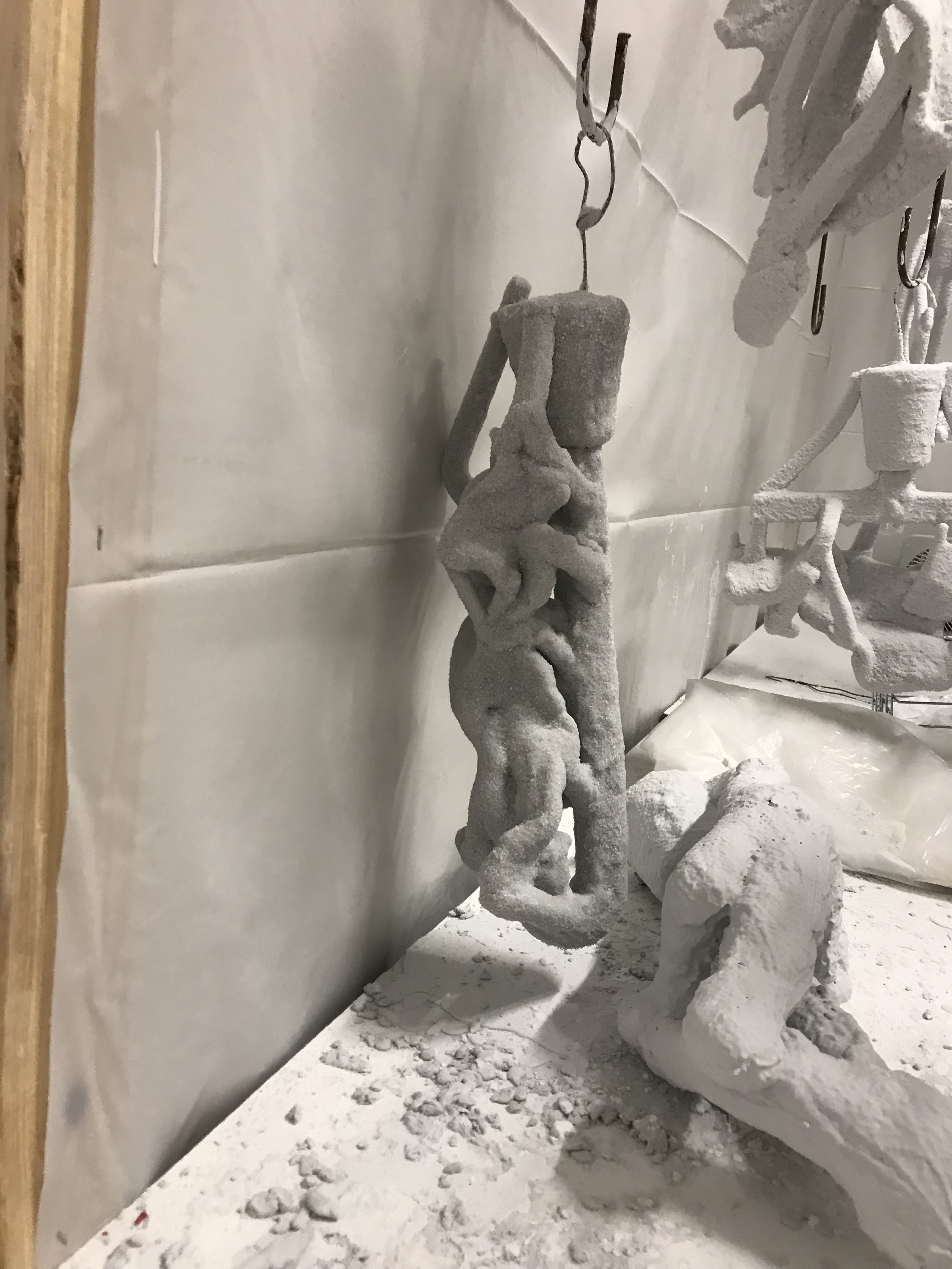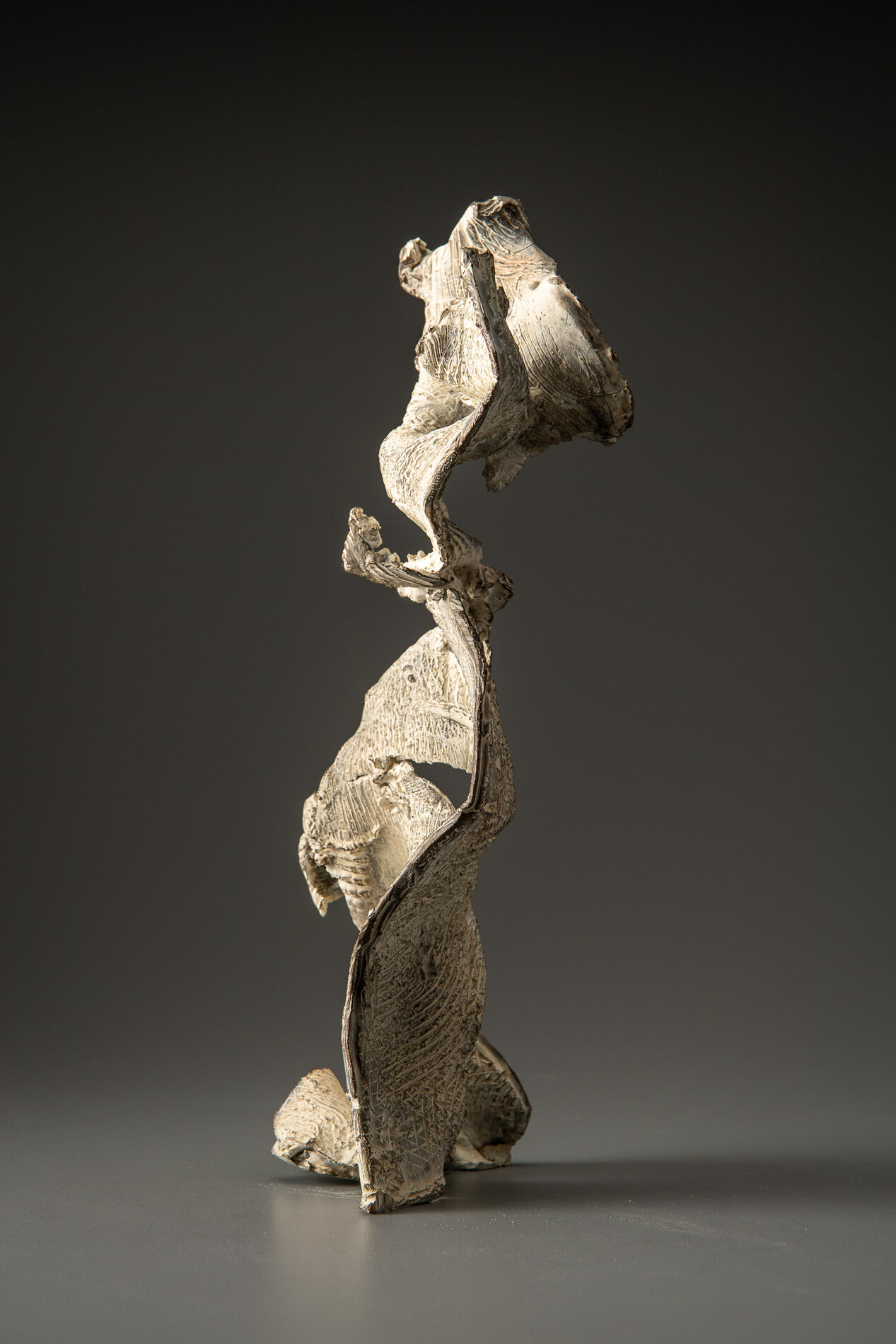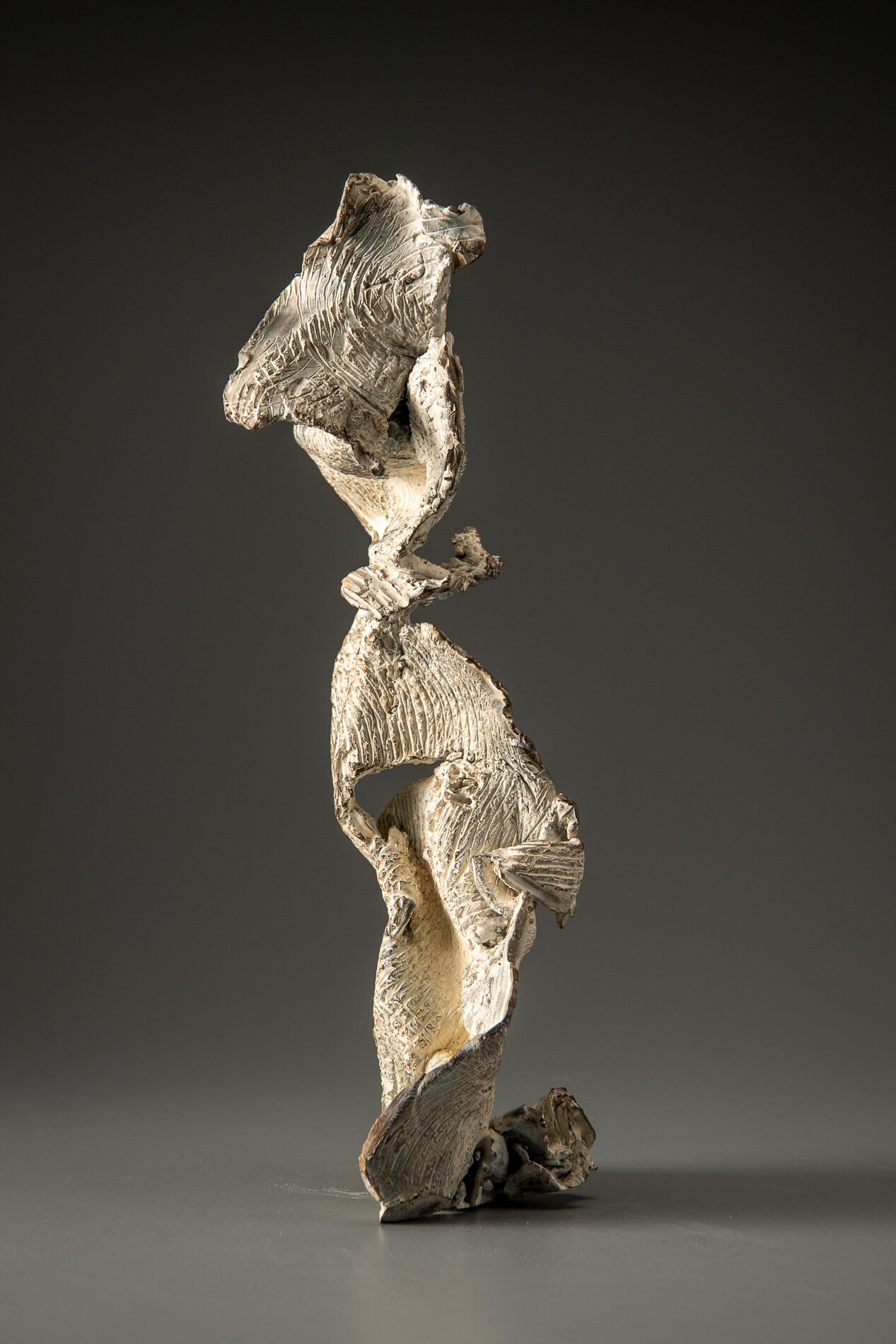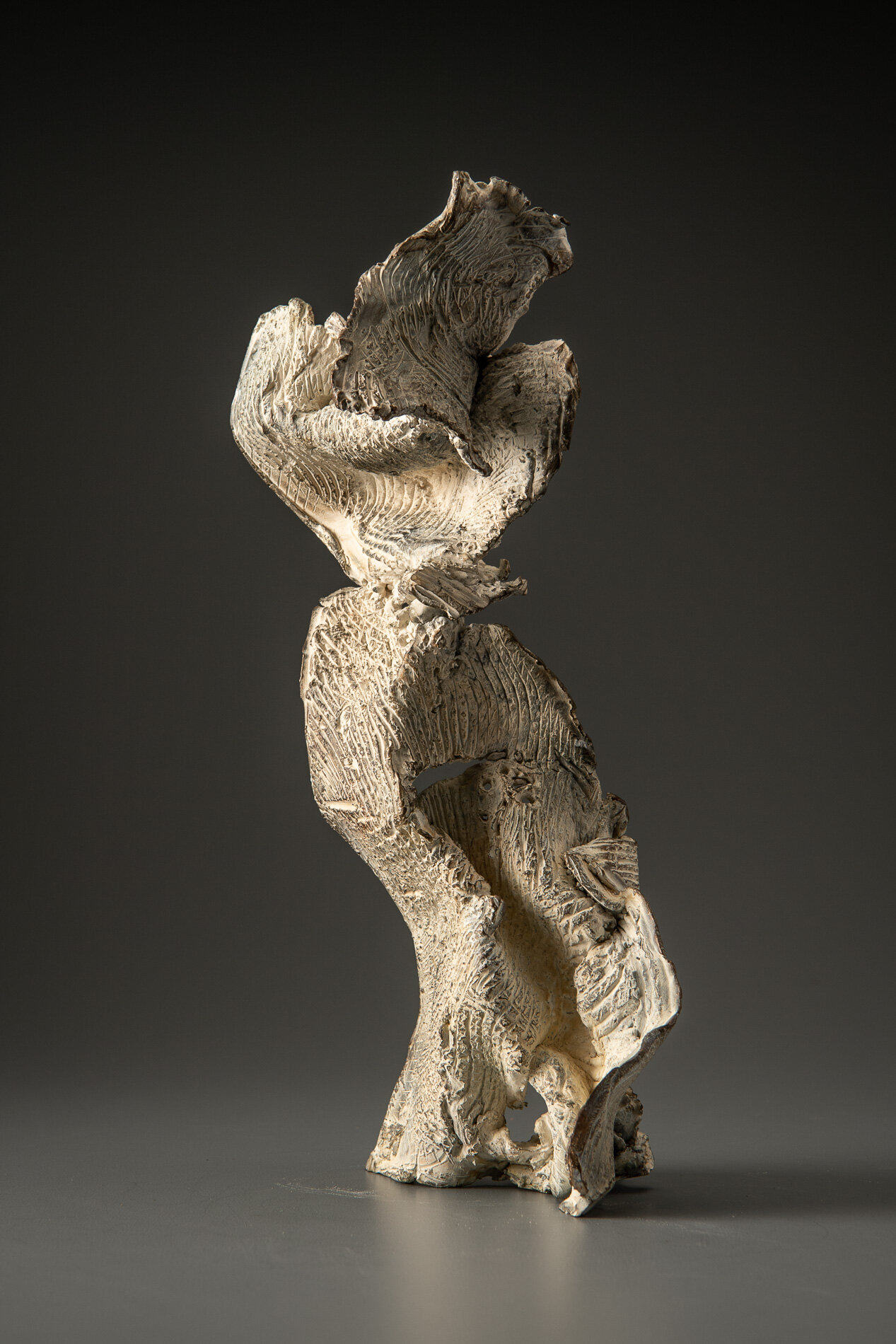Lawndale Art Center — Symbiosis environmental art activism project announced
Lawndale Art Center a staple on my radar as a possible venue for an environmental art exhibition. The sculpture garden, primed to be relandscaped in a manner that could communicate any number of environmental issues in my head.
The Lawndale Art Center Sculpture garden before the 2019 re-landscape.
I have had a few casual discussions with Stephanie about these ideas in the past, however other opportunities came my way, and frankly, I dropped the ball.
During the first COVID 19 quarantine, Lawndale Art Center reached out to me regarding their sculpture garden. They were interested to know if I would assist them with some weeding in their newly landscaped sculpture garden, I often volunteer there. When I heard the words, “newly landscaped sculpture garden,” my heart fell to the ground. I had blown it, I missed the best art venue opportunity to create a piece that looks at urban landscape as a found object. I was crushed, disappointed and angry at myself. I decided to focus on my Endangered Knowledge: The Soul of Humus, a piece I am creating for Sculpture Month Houston. In turning Lawndale down I sent them a copy of the proposal I made to SMH. A few days later I remember thinking to myself, “well you blew that opportunity, you will never get a show at Lawndale now.” A few weeks after that— they called me back and asked me to meet them at the sculpture garden. Masked I met with Stephanie and Emily and they asked me to do a site-specific environmental piece in the newly relandscaped garden. It was the last thing I expected—A dream come true was not in my mind of possible COVID19 realities. We also discussed their need for some happiness in the garden. The garden does not have any beneficials planted. Sympathetic to their need for some visual happiness I offered to plant a few flowers.
By this time it is unbearable—Houston—July—Hot.
What can you plant in July and have it not fry, if anything? I am not an experienced gardener I am an artist/activist and a citizen environmentalist—but my friend and past President of the Harris County Master Gardeners, artist, and curator is a very knowledgable gardener. A super busy Renassaince man, Will Isbell kindly offered to meet me on a Friday evening at the garden to see if there was anything I could plant that would not die in this July heat. There was not, but we did have a great talk.
We both saw the existing garden in the same way a missed opportunity for an environmental artist. And then it hit me. I suggested that I propose to Lawndale that the two of us do a project that takes the existing new traditional landscaped garden and use it as a found object to create a piece to activate change in Houston’s landscape. Will did not hesitate.
The question was how do I get them on board. They have already spent good money and the garden by any standards is beautifully done. One thing everyone knows about Lawndale, it is an art space for the voices of artists breaking boundaries and unearthing contemporary knowledge, nothing is too daring for Lawndale. They are the space in Houston to open minds. They were encouraging and interested in this new idea and wanted me to continue working on a concept for a solo environmental piece as well the piece with Will.
I am still num with these two opportunities and excited with the potential to instill hope and heal the environment.
Lawndale announced the project Will and I are doing together last week. Below is the proposal for the work. I wrote it in early July, as I read the opening paragraph today, with California on fire, and Houston flooding again I am taken back by how much the world has changed since I wrote it.— and not in a good way.
Lawndale Sculpture Garden Proposal
Cindee Travis Klement and William Isbell
What is to be gained in the year 2020, the year of perfect vision? In our largest cities, a tiny virus is killing our most vulnerable, crippling our strongest economies, forcing our families into food lines, and providing kindling for social reform protests. In the natural world tucked within our largest cities, this same tiny virus has improved the air that we breathe, returned fireflies to our summer nights, and allowed wildlife to inhabit our neighborhoods. The connection between the land, plants, mankind, and wildlife in urban environments has never been more evident.
What is to be gained in the COVID 19 moment of enlightenment: our eyes have opened to the state of our living systems, and we have discovered that unimaginable change is possible. We have seen that we cannot wait for the tests to tell us if we are sick. Without design, we have found an unprecedented moment, we have gained an opportunity to change.
SYMBIOSIS
As visual artists and art activists, we will connect soil health and the health of our city. We will create a living piece of site-specific art activism that will reimagine the urban landscape and answer the question — how do we holistically restore an ecological balance that can coexist in Houston with nature/ wildlife through sculpture and community involvement. We see the Mary E. Bawden Sculpture Garden's terrain with its manicured, status quo landscape as our found object. With ordinary tools, organic matter, with the help of the community, we will sculpt it into the armor that historically protected Houston’s geological epidermis and gave life to its keystone species — the Coastal Prairie ecosystem. The title of this found object sculpture is Symbiosis. Over time Symbiosis we will morph into not only a landscape but also a soundscape that changes kinetically with the seasons.
Lawndale’s Mary E. Bawden Sculpture Garden’s Symbiosis will be a catalyst for change. In addition, it will be functional as a contemporary art exhibition space, a piece of functional activist art as well as a healthy ecosystem/habitat: a sculpture garden that heals and honors the history of the land.
Physical Description of Piece
Once the parameters of the project more are specifically defined we will insert the specific plants, their ecological roll in the
design and define the work.
Environmental Impact
Soil scientists around the globe agree that solutions to global warming, soil erosion, water runoff, drought/flooding, loss of wildlife habitats, and species extinction are rooted in the treatment of our soil — the skin that covers our planet, which includes our residential and small business landscapes.
Restoring the native prairie vegetation increases soil absorption of water and slows floodwaters on land, decreasing water runoff. For every 1% increase per acre of biological organic material, the soil can hold an additional 20,000 gallons of water. Given Houston’s extreme building practices and concrete hardscaping, reimagining the landscapes within Houston's 600 square miles of real estate can significantly impact the region's flooding. In addition, the roots of vegetation in a coastal prairie can extend from eight to fourteen feet deep; these roots sequester and store carbon like an upside-down rainforest, cleaning our air.
Value of Location
Change can happen at lightning speed when innovation is coupled with imitation.
The current state of Lawndale's sculpture garden provides the perfect opportunity to break the mindless conformity that dominates Houston's urban gardens/yards. The sculpture garden has the feel of a perfectly manicured, traditional front yard, making its size and plant selections relatable to the general public.
With the Houston Arboretum transformations, Katy Prairie Conservancy, Buffalo Bayou, and the new Memorial Park renovation, Houstonians have awakened to the importance of native Coastal Prairie landscaping; however, those sites are enormous tracts of land. It isn't easy to visualize those landscapes outside the parks. This permanent and living metamorphosis of Lawndale’s Symbiosis will provide the 2020 vision of transformation by imitation for yards throughout Houston. It will shift mindsets by prompting Houstonians to question Houston’s urban landscaping and imagine a holistic Houston that protects the environment by balancing human, natural and economic systems.
Value for Lawndale Art Center
An art institution that looks at its community holistically to include not just a monoculture of humans but also beneficial plants, animals, and micro-organisms will be groundbreaking. Symbiosis will cultivate a medley of life that historically has defined the place, has impacted its economy and attracted its people. Lawndale’s Symbiosis will leverage this endangered knowledge with a living site-specific art installation that provides the artistic vision that changes hearts and minds. It will connect the history of the land to contemporary art. Using additive and subtractive sculpting techniques and nature the Symbiosis of the Mary E. Bawden sculpture garden will become a living love letter from our past to our future.
Ecological impact of Houston
With 2.3 million people living on a footprint of 600 square miles, close to the Gulf of Mexico, located along the migratory bird pathway, Houston is an urban wildlife sanctuary.
Changing Houston's ecology will profoundly impact our oceans, human life, wildlife, and microbial environmental health. Let’s not miss this unprecedented opportunity and heal the skin of the planet and our people.
Installation Process
The beauty of this piece is to have it be a catalyst for inspiring homeowners and businesses to imitate the change and heal their landscapes too. We will Involve the community to take on an active role in the transformation. Installation of the piece will engage and educate the community in ways to be defined after specifics of the piece are worked out.
Lawndale after one of our early Symbiosis meetings.
Beautiful new fence and Jasmine and crepe Myrtles.
Olive trees, African Iris, Dwarf Yupon Holly, Gardenias, Asian Jasmine, Crepe Myrtles -6 very popular landscape elements across Houston.
Will’s and my found object — Lawndale Art Center, Mary E. Bawden Sculpture Garden
World of Hum and Rumblings experiment
I have often wondered how my monotypes would look with a kinetic showdown piece. This is the first print I have tried with the kinetic sculpture. I think it is worth exploring.
This is a screenshot of a message I received on Instagram In the above post. I am please to make an Apis Dorsata and help spread the word regarding the bee problem in India -
Apis Dorsata - ghost #2 watercolor monotype print 30” X44” detail of a 458 sq.ft work that addresses the plight of native bees worldwide. ”rock bee” its common name is responsible for every third bite of food in India.
Apis Dorsata - Rock bee. 30” X 44” watercolor monotype
Apis Dorsata - Rock bee. Ghost
30” X 44” watercolor monotype
Apis Dorsata - Rock bee. Ghost 2
30” X 44” watercolor monotype
Rumblings - Xylocopa micans
A male southern carpenter bee- This bee was sleeping on my Salvia the morning of July 4th. The male wild bees do not live in nests. When they emerge they fly out looking for females to breed with. When the females return to their nest to sleep the males curl up to an petal.
Xylocopa micans I
Xylocopa micans II
Xylocopa micans II ghost
Image from my video
Rumblings - Bombus Morrisoni - repeat
Bombus Morrisoni II
Bombus Morrisoni II Ghost
I was not happy with the first Bombus Morrisoni so I made more. The first is swimming in violet blooms
Bombus Morrisoni III
Bombus Morrisoni III ghost
Rumblings Monotypes without a printer.
Sometime in 2019 or late 2018 I discovered the USGS photographic library of wild bees. I was overwhelmed at the number of species and their individual beauty. They are jewels of the insect world. These facts combined with the reality that most well educated people believe that there is just one bee species - the honey bee. There are 20,000 species. How a creature who is responsible for our food could be misunderstood to this existent is baffling. Scientist just started realizing the error in their studies last summer. Committing to telling the story of the plight of the most important being on the planet is a worthy story. I have always felt the need to support underdogs.
Below us the artist statement for the project as I incusion it today. Artist statements remain fluid as I work on big projects.
RUMBLINGSA rumbling in the distance is nature's way to alert living creatures to their environment. Rumblings; monumentally draws attention to the 20,000 unknown species of threatened wild solitary bees. The bees that can not bee industrialized. The watercolor ink carefully manipulated on the fifty interconnected monotypes to reflect the synergistic, aqueous effect of; the unexplored bee species superior magnetic attraction of golden dust, the movement of the anonymous Keystone species dedication to pollinate, and their fragility due to the applied chemicals that flood industrial agriculture. With Rumblings, there is knowledge and knowledge is power; it is a resounding call to all for action.
The COVID 19 quarantine in March was a huge buzz kill to this series. These are all monotyoes. I use the plexiglass surface to create my water effect that I then press into the paper. I am very attached to this method as the best way to communicate this work for a few reasons. 1. It is a process I created and as far as I know no one else creates monotyoes with this type of mark making., 2. The watery look suggest the use if pesticides that are impacting their extension and lastly the tiny details that make up the bee is suggestive of pollen dust. I have been creating this pieces in MFAH beautiful Glassell studio school printmaking studio. With COVID that us not an option for me.
Since March, I have stitched bees and tried to be open-minded to another process to complete the series. I finally decided to see if I could hand press a 30” X 44” print in my studio.
Here I am applying the ink to the plexiglass. On the wall is a photo of Bombus Dahlbomii, the largest humble bee in the world at 2” long and endangered if it us not already extinct. The photographs are stunning. The photographs are taken if dead bees. In ny pieces, I try to put movement and energy back into the buzz pollinator.
Here I have just pressed the plexiglass with the watercolor ink bee image onto the wet paper. And surprise surprise surprise.
Bombus Dahlbomii IV
I have made three other attempts to print this monsterous fluffy ginger and not been happy with the results.
Bombus Dahlbomii IV Ghost.
The prior attempt are below. Getting a mono-colored fluffy bee with out muddying the ink was tricky.
Bombus Dahlbomii Day I
Bombus Dahlbomii Day I ghost
Bombus Dahlbomii Day II
Bombus Dahlbomii Day II ghost
Bombus Dahlbomii Day III
Bombus Dahlbomii Day I'll ghost
I am hoping the Bombus Dahlbomii day IV pieces cut the mustard. I am feeling hopeful and extremely excited that I can create monotypes without a press Is this non-verbal size.
Why soil?
“The soil is the creative material of most of the needs of life. Creation starts with a handful of dust.” - Dr. W. A. Albrecht ph. D.
That is a powerful thought. How important is soil to our health? For me it is clear.
And it is not dirt, it is not clay, it is humus living soil.
This quote is deeply tied to all of my current work, in The Endangered Knowledge piece that I am in the early stages of welding soil is the material that will become the protective layer of the keystone species, in Subterraneous Secrets soils energy is stabilized and captured through root systems, in Mute Testimony, it records its history, in Gust the life it provides is Endangered. In the photography of life in my cement pond, it establishes natural rhythms and compliments the other living systems. The pond is a complete ecosystem; it is free of pesticides and herbicides. In this type of ecosystem, even the blooms in their last phase of life are beautiful as the tiny microorganisms convert them back into minerals that build soil health. #inmycementpond In this image, you can not see the humus, but you can see the magic in the life it brings when we allow it to thrive in a natural state.
Endangered knowledge: The Soul of Humus #17 Cowbirds
I just read an intesting article; how Cowbirds are hedging their bets when choosing surrogate birds to hatch and raise their young. Another instance that supports the theory that diversity is the ticket when it comes to the survival of a species.
Coincidently I picked up the bronze Cowbirds yesterday. They are ready for me to recreate the texture where they were damaged during the spruing process. Once that is complete I will deal with their patina. I should wait and decide on their finish once the abstract bison is further developed. That said I am excited to see how the materials will look in a polished finish. Below are closeups of each bird - just for the record.
The finishes are very powdery looking and flat because they were just sandblasted. When I decide on the patiba the textures will really show up.
I took a risk when I decided on the manner in which I would create the birds. The Cowbirds are constructed in a primitive manner. And they look extra primitive laying on the faux bois chair. Context impacts the way we see. I feel hopeful the organic and rough construction will work on the abstract beast they will be attached to. Roughly constructed they support the story, polished perfectly detailed birds would not relay their connection to the geography and mammals. I realize I have not taken the safe root and hope I didn’t need to hedge my by as the Cowbirds did theirs.
The big bird side 1
Opposite side.
On this image you can see a smooth surface from where the sprue was cur off. One spots the I will retexture.
From the top
Bird 2
Bird 3
Derail shot of bird 3 - you can see the seeds and grass stems.
Bird 4
As I recall this one gas some bluebonbet seeds in it's back feathers.
Bird 5
Texture gives me good goosebumps.
Subterraneous Secret II
Subterraneous Secret is part of my Endangered Knowledge work. For several years, I have been researching grass-fed food production, attending soil conferences, and visiting regenerative ranches. Research in these fields shows how to fight desertification and reverse climate change through regenerative agriculture practices. Interestingly, this natural history of living soil, how it evolved with roots, fungus, plants, food, and animals, carbon and their essential roles within microbial communities in human health, is not common knowledge.
Subterranean Secrets II
bronze
Endangered Knowledge: The Soul of Humus #16
Art/computer work that has interfered with my welding but I never miss an opportunity to collect native plants. I have converted an old kayak rack into a plant drying rack. Stacking up and drying out.
Drying native grasses
Recording natural history - ”Mute Testimony”
Mute Testimony.
3” X 6” X 4”
bronze
phot by Nash Baker
A fossil is our planet’s recorded history, the memoir of a life in a place, time, ecology, and evidence of global warming. It is Endangered Knowledge.
Many processes in art and the natural world lead to fossilization, including casting or mold making. I crafted a mold of a fossil that one of my children found at my son Griffin’s 8th birthday party in El Paso, Texas. It was a fossil hunting party at Cerro de Cristo Rey. (The intersection of two countries and three states, a special place.) A prehistoric relic, now a family treasure, I thought it would be meaningful to make a mold and cast it in bronze for each of my two children, a reminder of their childhood. A mold-of-a-mold a fossil-of-a-fossil. I found the redundancy poetic.
My son is now 31 years old. I have probably walked by the fossil once a day since Griffin was eight years old and did not think twice about it. Casting, it has forced me to think about the form and its value as an object of art. Evidence of aquatic life resurrected from the middle of the Chihuahuan desert— This poetic symbol of desertification will find meaningful ways to wander across disciplines into future environmental works.
Hearing, “this desert was once an ocean.” did not use to phase me. Thinking about the mineral remnant of a sea creature surfacing in one of the driest terrains in the US gives me pause; it makes me consider how we can live our urban lives and preserve natural systems.
I cast three additional fossils to share with others who are interested in natural history; two are finished in a natural patina and one in a contemporary finish — polished stainless steel.
Traces of ancient life tell story of early diversity in marine ecosystems
Stainless Steel finish changes everything 🤔 more to come
What We Think, We Become from conception to the completion.
My goal for this piece is to embody joy, celebrate life, be complex yet straightforward, and have moments of imperfection.
I will attach to the wax sculpture red wax channels (sprues) and a brown wax cup.
Below the piece is sprued up and ready to dip.
The dipping process builds layer by layer a ceramic shell around the sculpture and sprues. Once the Shell is built I will burnout the wax leaving a hollow cavity to pour the bronze in.
Dip 1 Slurry only
Final coat 24 hours after drying
Cutting the top of the cup and drilling holes to help the expanding gases escape when the wax is burned out.
The piece is now ready to be fired. The firing will harden the shell and melt out the wax sculpture, leaving the cavity for the bronze to be poured into. The wire sticking out will fall out when the wax is burnt out.
We poured the bronze into the shells last night. Now that the shell is cool it is time to break it off and see how it turned out.
the pour-
my shoulder has taken all the pounding it can. I will have to get help to finish breaking off the shell.
In the below images all the metal work is done and the piece is ready to patina.
Adding the white marble patina
The Shadow of the Texas Rangers- artist statement update
As life happens, the lens we see through shifts. The lens I interpret this work through has adapted to current events.
As a result, I am updating my artist statement.
The Shadow of the Texas Rangers - late 1920's, The Texas Rangers in Fabens, Texas (a suburb of El Paso). During prohibition, the Texas Rangers traveled to the Texas/Mexico border, to deter the smuggling of illegally distilled alcohol. While on the border, they boarded in my grandparent's home; they became family friends. My reference photo for these drawings of the Rangers hung in my Grandparent’s home. As a child in the 60’s the photo always intrigued me. I was in awe of the well-heeled, respected law officials confidently posed in front of the rugged mountain and their curiously shaped shadows. I wondered why Granny Gene had a photo of the mythical cowboys and their rifles.
My father did not remember much about the Rangers; ironically, he did remember having a house full of thirsty Texas Rangers and accompanying his father to the edge of the Rio Grande River. His father would leave cash under a rock, the next day a bootlegger from Mexico would wade across the river on a mule, retrieve the compensation and place bottles of booze in the hole under the rock. This is when the term ”mule” surfaced.
The proud history of the Texas Rangers I grew up with has suffered from stories of abuses of power. In the historical photo, the overpowering southwestern sun reveals the dark shadows that tarnish the Rangers’ reputations.
Looking at this image today, through the experiences of 2020, the focus rests heavily on the dark shadows in law enforcement. Unfortunately, the deplorable actions of a few can ruin the reputation of a group. In this drawing, there is a balance of light and dark. It is important to remember history as it was experienced by the people living at the time but it is also important not to turn a blind eye to the dark side of our history. Finding this balance is where we are in 2020. It is time that we hold law enforcement to higher standards and that they find ways to police their own.
There is more good than bad. If you look for it, you will find it. The only reliable way to instill change is to lead by example and to recognize and celebrate those who are doing it right.
what we think we become
I started this piece 1 1/2 years ago but neglected to have it photographed until this week. Seeing it through the photographer’s eye, it has an additional layer of meaning in 8/2020.
Originally it was a maquette for a memorial piece. We ended up going a different path for the memoriam. Personally I was happy this piece emerged from the event and cast it in bronze. It resonates with me because years ago I became fascinated, completely sucked in by modern neurology. Neurology was my obsession. I read everything a Mom could get her hands on. My favorite was Phantoms in the Brain by V. S. Ramachandran. The brain is amazing and especially since neurologists have learned that it is plastic and is changed with everything you do, everything you tell yourself or others tell you changes your brain. This knowledge is what gives every human a chance for hope. Dreaming is the first step, and self-talk is hugely important. You can control how you see the world, and how you see yourself, “fake it until you make it works“. What you think you will become”.
The additional layer - living through a pandemic is choosing how one reacts to stressful and depressing situations. Humans choose how we react and how we see. “what you think you will become”. The texture of the piece is composed of repetitive arched lines, they are mirrored in the profiles/contours of the work. It is an abstract sculpture but I clearly read “what we think we become”. What we look for we will find, 8/2020 is a good time to control your thoughts and look for the light. If you look for it you will find it.
“what you think you become”
bronze
12” X 4” X 3”
Working style philosophy
Range by David Epstein - in my mind is a must-read for any artist, creative writer, inventor, scientist moms or anyone who solves problems.
https://pepperdine-graphic.com/book-review-lessons-for-higher-education-in-david-epsteins-range/
”Everyone needs habits of mind that dance across disciplines.”
- D. Epstein
“Habits of mind that dance across disciplines-“ - D. Epstein
I love that quote; it sums up how I think and supports how I am driven to work. Several times during studio visits with people that are in the art world and that I have tremendous respect for, they advised me that I should focus on one thing, one media to work in, or one subject. It helps in branding. It also allows for intense and thorough investigations in an area. It is a smart way to go. I understand what they are saying. It is a lot easier to market art made out of one media or maybe two different medias. It allows you to be recognized by the work.
If I were 20 years old and created art for financial gain- to eat and pay my rent, I would 100% take the advice. Since I am 63 years old and after years of working long hours (not in a visual field), I now have the luxury of knowing where my next meal is coming. Branding is smart, but it is not what interests me about making art. The creativity, the making of, and the message of are what inspire me. The freedom to be creative and not have to worry about the marketability, durability, or popularity of size, material and color allows me to do work that is important to me, with materials that speak to the issues that keep me up at night or move me. It is a luxury not to have financial pressures. Having this luxury, I feel responsible for using the freedom I am afforded to do work that will help create a better world. It does not mean I can’t have fun with it. I love making and feeling passionate.
I have many interests, and I try to be open to new ideas. I believe creativity comes with exposure to life’s experiences, both good and bad, and life’s failures. I often try to break the rules set out by those who came before me regarding creating, and looking for new ways to find my voice. It comes from the willingness to try new things, ”to grasp further than my reach.” -Browning?
Every new idea I have, I first think if it should be expressed 2D or 3D or both. I have to consider the problems that will arise. I have to look far enough to solve the next problem, but not so far ahead that it is daunting. That is a fine line. Reading Range confirmed my beliefs and uncovered even more justifications for staying focused on my path of diversity. . There are connections in my creative wanderings, they are not as visible as using one media or one subject, but they are there for those that take the time to look and think. Good or bad, this is how I need to create. Maybe someday, but for now, I do not want to shift my mindset. I want to keep expanding my visual and sculptural vocabulary. I want to look for ways to interleave my work, create more mental schemes, broaden my thinking, think outside my experiences.
I am naive enough to hope that one-day, art historians, and or critics will see the connections in my work and maybe be glad I didn’t do one thing. Until then I have to figure out where to keep all this work.
My studio July 2020
I took time this weekend to photograph my studio- just for the memories. I never dreamed I would have an art studio.
One of the ppleasures of having a studio, Is it provides a space to meet with other artists, friends, and art lover acquaintances and get their reactions to my work? Everyone perceives art differently, and it is incredibly beneficial to get feedback from a variety of folks.
Osmia Illinoensis- mason bee
I selected Osmia Illinoensis to add to Rumblings when I read
Osmia Illinoensis is a mason wild bee. It is a stingless, solitary bee whose territory was from Illinois to Texas. Over 25% of the 139 native mason bee species in North America are at risk; 14 have not been recorded for decades. There are two things you can do to help restore these tiny creatures that support the world's sustainable food production. Plant native plants 🌺 and grasses 🌾 while minimizing the use of pesticides 💦. Second buy local organic food and products 🥬🍅. buy local organic food and products 🥬🍅. buy local organic food and products 🥬🍅. buy local organic food and products 🥬🍅. buy local organic food and products 🥬🍅.
buy local organic food and products 🥬🍅. buy local organic food and products 🥬🍅. buy local organic food and products 🥬🍅. buy local organic food and products 🥬🍅. buy local organic food and products 🥬🍅. buy local organic food and products 🥬🍅.
Osmia Illinoensis
30” X 44” watercolor monotype.
Day two, #2 the ghost
I struggled with my technique capturing O. Illinoensis features, those tiny white hairs were impossible, the magnificent colors of the hard exoskeleton, all the while giving her life, movement and remembering to keep the watery effect that suggests the devastating impact chemicals are having on this tiny creature.
Day 3 caran d’ ache monotype
The ghost
Endangered Knowledge: The Soul of Humus #15
Another day of building the bone structure of the face. The armature is more detailed than the sculpture will be. As I work I remind myself that the armature just needs to support the masses of dried mud and dried grass. It will not be visible under the herbaceous skin. I can’t seem to stop myself. I think it make me feel closer, more connect to the bison.
It also keeps me away from the news- COVID 19.
Today I worked on the lower part of it's cheekbones and then I added a rear jawbone.
Looking up the mouth and nose of head minus the lower jaw.
The old guys face left side
Looking through the skull
The right profile.
On the Road to Roam
January 19, 2020
We are on the road to Roam, and I am feeling a little concerned. I believe that we as a society are not connected to the raising/producing, culling, and processing of our food. With this disconnect, what is essential has been lost. This not only impacts our health but also our environment (including the bees) that we are borrowing from future generations. It is easy to be judgmental and to point fingers. If I am going to judge our current food production system, I need to experience the process that I believe is a healthy and responsible alternative. I need to be willing not only to talk the talk but walk the walk. Thursday, Curtis, and worked Roam’s Bison Roundup. We were nicknamed the gatekeepers. One female, after careful and thoughtful analysis, was selected to be culled today. This is not going to be easy, but I will be a better human from the experience......... on the road to Roam.
Opening the car door the last thing I hear on the radio is, ”everything is dust in the wind, ” for one second I find comfort in these words.
The ranch Anatolian livestock guard dogs greet us at the ranch entrance.
The herd including the cow to be culled having a relaxing morning grazing on Texas prairie grasses. The cow in question will not be separated from the herd, she will not be stressed and will not feel any pain. This is how you humanely harvest an animal. This is not how industrial Agriculture harvests meat.
That explained it is a heavy feeling knowing that a life is being sacrificed. Being aware of what is being lost in order to put a high quality protein on the table makes every ounce of meat more valuable. Nothing should be wasted. The experience changes how we value animal protein.
I participated for two reasons; personal growth through awareness and a deeper knowledge for a body of work whose concept I am working on called Giving the Bird.
Endangered Knowledge: Soul of Humus #17
I started the lower jaw today. I spent the majority of the day researching the structure of the lower jaw and its movement as the bison chew.
Here is a collection of my reference material.
Bison grab a tuft of grass with their tongue, then they pinch it off by pressing it between their tongue and their front lower teeth. They do not have top front teeth. They then swallow it whole. That is the beginning of a 24-hour digestive process.
I love this image, I took it last January at Roam Ranch right before the roundup. I think this is the one they call Poppy. Poppy is very curious and friendly. She is checking me out as she catches rain drops on her tongue.
You can see the lower jaw through the upper jaw here. It is slightly off to the right of the bison. I want him chewing away and want to exaggerate the movement. I will probably bend it a little more askew this weekend.
Here the chewing lower jaw is more obvious.
View from the rear or top down.
Friday, I am committing to writing the Lawndale proposal- rewriting and rewriting and rewriting.

